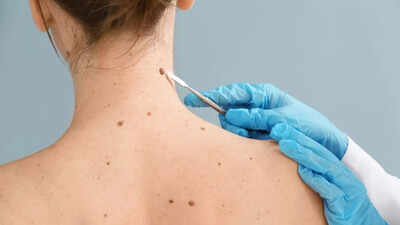ARTICLE AD BOX

When most people think of skin cancer, they picture an unusual or changing mole. While this is a well-known warning sign, it’s far from the only one. Skin cancer can appear in many forms, and sometimes the symptoms are so unexpected that they are mistaken for minor skin issues.
Because early detection is the key to effective treatment, recognizing these less obvious signs is crucial. Beyond moles, skin cancer may show up as persistent sores, unusual patches, or even non-skin-related symptoms. According to a report by the Moffitt Cancer Center, these lesser-known signs are important to recognize since they may be linked to skin cancer.
5 lesser-known skin cancer symptoms
Scaly or rough patches
One early sign of skin cancer can be a scaly, rough patch of red or brown skin that doesn’t heal.
These patches are often flat and slightly raised, resembling eczema, psoriasis, or even a stubborn sunburn. Unlike common rashes, however, they don’t improve with moisturizers or over-the-counter creams. Basal cell and squamous cell carcinomas are most likely to present this way, especially on sun-exposed areas like the face, ears, scalp, and arms.
If the patch feels crusty, bleeds easily, or continues to grow, it’s important to have it checked by a dermatologist.
Itchy or irritated skin
Basal cell carcinomas may first show up as a small itchy, irritated patch of skin. Many people dismiss this sensation as dry skin, insect bites, or mild allergies, but when the irritation lingers, it could be a warning sign. The itching often intensifies over time as the lesion slowly enlarges. Since basal cell carcinoma is the most common type of skin cancer, occurring in millions of cases annually, any persistent irritation should not be ignored.
Early evaluation can help ensure that a tiny spot doesn’t progress into something more dangerous.
Open sores that don’t heal
Another possible sign of skin cancer is an open sore that refuses to heal. While minor cuts and scrapes usually close within a week or two, a cancerous sore often reopens, scabs over, or bleeds repeatedly. These sores may appear shiny, pink, or even resemble the aftermath of a severe sunburn. People often overlook them, thinking they’re caused by scratching, shaving, or irritation.
However, repeated bleeding and failure to heal are major red flags for basal or squamous cell carcinoma and should always prompt medical evaluation.
Crater-like lesions
Squamous cell cancer sometimes develop into crater-like lesions — shallow, volcano-shaped growths with raised edges and a depressed center. These lesions may ooze fluid or form a crust that doesn’t go away. Because they look similar to infected pimples, cysts, or insect bites, these growths are often mistaken for minor skin issues.
However, squamous cell carcinoma can spread if untreated, particularly to lymph nodes.
Any sore or crater-like lesion that changes in size or color over weeks or months needs urgent attention from a dermatologist.
Symptoms of skin cancer beyond the skin
Melanoma, the deadliest form of skin cancer, can spread beyond the skin to other organs. This means its symptoms aren’t always visible on the surface. For example, if melanoma spreads to the lungs, it can cause shortness of breath or a persistent cough.
If it reaches the brain, it may trigger headaches, dizziness, or vision changes. These non-skin symptoms are especially dangerous because they are often mistaken for unrelated health issues.
Understanding that melanoma can go beyond the skin is critical for catching it before it advances too far.
Why early detection matters
Skin cancer is one of the most treatable cancers when caught early. Most basal cell and squamous cell carcinomas can be cured with simple outpatient procedures if detected promptly. Even melanoma, though aggressive, has an excellent survival rate when found in its earliest stages. The key is to pay attention to changes that don’t go away: sores that linger, patches that thicken, or lesions that grow or bleed. If something on your skin doesn’t look or feel right, don’t wait — see a doctor.
Early action could save not just your skin, but your life.



.png)
.png)
.png)
















 1 hour ago
2
1 hour ago
2









 English (US) ·
English (US) ·